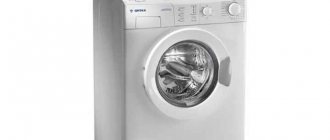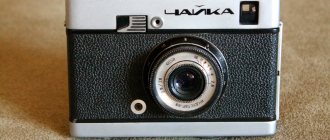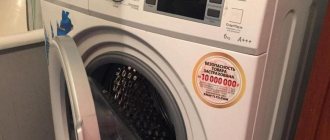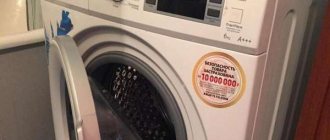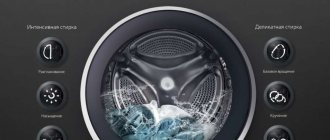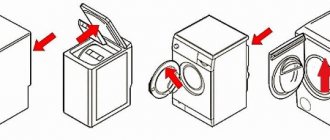The first domestic washing machines began to be produced by the Riga Electrical Machine Building Plant REZ during the Soviet Union. The prototype was the model of foreign countries that had already mastered the production of washing household appliances. Individual components of the “Riga” series washing machine models that were in demand in the USSR are still used in dachas to this day in new applications.
- Establishment of Riga washing machine production
- Features of Riga washing machines
- Popular REZ models
- Recommendations for using outdated equipment
- Catalog of washing machines with reviews
Riga 54
At one time it was possible to wash clothes with a dry weight of 2.5 kg. The engine power demonstrated by this machine over a long period of operation was 250 watts. At peak load it could in some cases reach up to 450 watts.
Riga 54 was produced starting in 1954.
During operation, the device that mixes the water performs reciprocating movements.
The washing machine body includes two cylindrical parts:
- top;
- bottom.
The latter houses the electric motor together with the gearbox, its suspension system and a water hose.
The upper part contains a centrifuge, which during washing rotates at a speed that can reach up to 800 revolutions per minute. There is also a stirrer and a special balancing device designed to ensure that vibration during operation is minimal.
The washing cycle could last no more than 6 minutes. To operate, it was necessary to pour hot water into the tank. Draining water could only be done manually.
This model used a centrifuge. In spin mode, the water was drained into a separate reservoir. It could be poured out after finishing the wash or refilled for subsequent treatment of the laundry.
The machine casing has three legs with wheels, thanks to which the washing machine can be easily moved if the need arises.
How washing units have improved
In 1966, a timer appeared in the USSR washing machine: an extremely unreliable unit that could be used to regulate the washing or spinning time. Thus, it was already an automated washing machine. It was extremely difficult for citizens to buy a car: they had to stand in line for three to five years.
A few years later they released the first semi-automatic car, it was called “Volga-10” and it was made in Cheboksary. They are still preserved in pensioners' homes.
Riga 55
This model was an improved version of the previous model. It was practically a copy of the Swedish Husqvarna car.
The motor operated from a network with a voltage of 127 V.
Based on the Riga 55 model, the following were also developed:
- Riga 60;
- Riga 8;
- Riga 13;
- Riga 15;
- Riga 17.
The number of cars that were produced daily was two thousand copies. In terms of annual production volume, we could talk about the production of more than 600 thousand washing machines.
Video
In the video below, you can once again familiarize yourself with the procedure for connecting the motor from the washing machine.
Mom, wife and just a happy woman. She draws inspiration from travel and cannot imagine life without books and good films. She strives to become an ideal housewife and is always ready to share her experience.
Found a mistake? Select it and click the buttons:
The first officially patented washing machine was made of wood and was a box with a frame, half filled with wooden balls. Laundry for washing and detergent were loaded inside and the frame was moved using a lever, which, in turn, made the balls move and grind the laundry.
Washing machines equipped with the “No Iron” or “Easy Iron” functions can wash clothes with little to no wrinkling. This effect is achieved through a special approach to spinning - it is performed at low speeds, with long pauses, and a small amount of water is retained in the tank.
The expression “soap opera” (“soap”) did not arise by chance. The very first series and shows that had a female audience were broadcast on television at a time when housewives did cleaning, ironing and laundry. In addition, to attract female viewers to the screens, commercials for detergents: soaps and powders were often played on air.
In the 19th century, washing ladies' toilets took a lot of time. The dresses were first ripped open, and then each part was washed and dried separately so that the fabric did not become deformed. After washing, the clothes were sewn again.
Astronauts, while in Earth orbit, solve the problem of dirty things using an original method. Clothes are dropped from the spacecraft and burn up in the upper atmosphere.
For washing small items on the road or in a hotel, it is convenient to use a regular plastic bag. Socks or tights are kneaded inside a tied bag along with water and a small amount of detergent. This method allows you to pre-soak things and wash them without damaging the fabric or wasting a lot of powder and water.
Washing machines have something to do with the origin of the expression “money laundering.” In the 1930s, American gangsters used a network of laundries as a cover for their illegal activities. By passing off the proceeds of crime as proceeds from cleaning clothes, they turned “dirty” money into “clean” money.
Riga 60
This washer was a further improvement of the previous model. New in Riga 60 was the use of an improved spinning device. Here it was possible to adjust the distance between the rollers. In addition, compared to the previous model, they were 56 mm longer. Adjusting the distance made it possible to spin not only regular-sized laundry, but also fairly large ones.
Some characteristics of this model:
- The weight of the car was 30 kg.
- The height without the squeezing device is 734 mm, and when it is installed it is 946 mm.
- The motor power is 150 W, it could use a 220 V or 127 V network.
You can wash 2 kg of laundry in one wash. Washing usually lasted from two to four minutes. After this, rinsing was performed. It took 1 - 2 minutes.
Cars for students
At the same time, the development of compact, small-sized washing machines was carried out, bearing the once proper and now common name “Malyutka”. Most of all, it resembled a huge chamber pot: a relatively small plastic tank and an electric drive on the side.
The car was truly miniature and was perfect for students, bachelors, and families with children who did not have the money to purchase a more expensive and powerful model. These devices are still in demand.
Riga 8
This model had an important advantage over its predecessors. It was equipped with a special pump to drain dirty water after washing.
This washer used a 350 W electric motor rated at 220 V and 50 Hz. There is a version of this washing machine that is designed for 127 V mains voltage. In this model, a timer was used to turn on, designed for a washing cycle of no more than 6 minutes. After the time allotted for washing has expired, the machine turns off.
This model had an additional metal spinner for washed clothes.
However, such a model, from a modern point of view, had modest capabilities: in one washing cycle it was possible to process no more than one and a half kilograms of laundry. In this case, it is necessary to fill the machine tank with 30 liters of water.
An important advantage of the Riga 8 machine was that stainless steel was used to make the tank. This feature ensured the ability to operate the washing machine for several decades.
The height is 690 mm, and with a squeezing device - 920 mm.
Scheme
The entire Riga model range had a unified electric motor connection diagram. At the moment, the electrical diagram of any machine can be downloaded on the Internet. The electric motor of the Riga washing machine was designed quite successfully, and over the years of operation it has proven itself to be a very reliable unit.
It had a starting and working winding, due to which it was possible to reverse if necessary. Due to the low power, there was no need for a starting capacitor. In Soviet times, craftsmen loved to use the engine from the Riga washing machine for various crafts. One of them was a small grinding machine for sharpening tools.
Riga 8 washing machine diagram
In general, the Riga plant created the market for washing machines in the Soviet Union. A whole era was lived, each family used the products of the plant. Even now you can often find advertisements on Avito for the sale of cars in working condition. And in the outback it happens that people even actively use them in everyday life. After all, the goods produced according to GOST standards were actually made conscientiously.
Riga 13
This model was practically no different from the previous one:
- You can wash up to 1.5 kg of laundry at a time.
- Water can be filled with no more than 30 liters.
- The weight of the machine excluding packaging is 25 kg.
- The height of the machine without installing an additional device is 690 mm, with it - 920 mm.
The motor connection diagram is similar to how it was done in previous models.
It began to use a hose that pumps the soap solution flowing back from the tank. The designers who worked on this model decided that this improvement improves the washing effect.
The power of the electric motor in Riga 13 was equal to 180 W, while the number of revolutions per minute was 1425. The motor operated from a 220 V or 127 V power supply.
Washing machines like “Oka” are an example of a never-ending classic
What is the structure of the most classic car from the times of the USSR and, oddly enough, today? The Oka washing machine is an activator type. It does not have a rotating drum, but a stationary vertical tank, at the bottom of which blades are installed - they mix the washing solution with the laundry. This design was distinguished by its simplicity and enormous reliability. Machines of this type could easily operate for several warranty periods.
The structure of an old USSR washing machine: there is a metal (now plastic) barrel, inside of which an electric drive and a fixed tank are mounted. That's all, actually. There are switches to turn on and sometimes, in some models, a timer that controls shutdown. The machine is extremely reliable and, if used correctly, practically does not break down. Typical rare breakdowns include leakage of the cleaning solution through the seals, destruction of the blades and burnout of the engine. The last two defects occur due to overload. Also, the manufacturer strongly does not recommend doing several washing cycles in a row. After completing one cycle, you should take a break and let the machine rest.
You will be surprised, but the Oka washing machine in various modifications is still sold today and costs about three thousand rubles. What is especially good about Oka is that it does not require insertion into the water supply.
Riga 17
In this model, the tank was made of stainless steel, just like in the previous model. The bottom was not located in a horizontal plane, but at an angle. It contained an activator, which, by means of rotation, mixed the water. One of the features of this model is the presence of two washing modes:
- soft;
- hard.
They differed from each other in the direction of rotation of the activator. The first of them was used for washing clothes made from more sensitive fabrics. The hard mode was used to process clothes made from coarser fabrics.
In the first case, the activator rotated clockwise, in the second - counterclockwise. The activator ribs are arranged in a spiral.
This model had an important improvement: an induction water heater was included in the design. It was not necessary to use cold water for refueling. The hostess could pour it and then heat it using the built-in device.
The use of this improvement had its significant drawback: heating water required high power consumption. When turned on, the required power was 2 kW, and with further operation it decreased to 1.2 kW.
Connection procedure
It is important to keep in mind that the washing machine engine does not start through a capacitor; a starting winding is not needed to start it.
Before we start connecting, let's look at what wires are in the transfer case of the washing machine engine:
The wires leading to the tachogenerator can be put aside - we don’t need them. In different models of washing machines, the color of the wires may differ, so you can get your bearings by the resistance - in those that go to the sensor, it should be 60-70 Ohms. After the extra wires have been isolated, the remaining ones need to be “ringed” to find a pair for everyone.
Before performing work, you should firmly fix the motor on any surface - the shaft will begin to rotate immediately after connecting to 220 V.
Typically, motors come with 4 leads (that is, they have 4 wires coming from the motor). If your motor has 5 pins, 6 pins, or even 7 pins, make sure there are no extra ones - we only need wires from the rotor and stator.
Next you need to connect the motor according to the diagram shown in the figure below.
According to the diagram, you need to connect the stator winding to the rotor brush, so you need to find the corresponding wires and make a jumper between them (in the photo it is indicated in pink), and then insulate it. The remaining two wires - from the rotor winding and the second brush - are connected to the network.
All that remains is to supplement the device with on and off buttons. In order to change the direction of rotation of the shaft, it is enough to transfer the jumper to other contacts.
On old Soviet units, motors with 3 leads can be installed. How to connect such a “miracle of technology”?
First of all, you need to measure the resistance: between pins 1 and 2, as well as pins 2 and 3, the ohmmeter will show 10 Ohms, and between pins 1 and 3 – 20 Ohms. The motor is connected as follows: pins 1 and 2 - to the network, pin 3 - through a capacitor to pin 1.
So, connecting the motor from the washing machine is not difficult. Use our recommendations, do not forget about safety precautions, and give a “second life” to your equipment.
Results
It is quite difficult to choose household appliances that meet all the requirements and wishes. When using an automatic washing machine, you can get washed items without making any effort, but at the same time there are obvious disadvantages - the price is not affordable for everyone, the risk of frequent breakdowns, and expensive equipment repairs.
When choosing a Fairy 2 washing machine, do not forget that it belongs to a budget series, the price of which is not comparable to the cost of any automatic analogue. In the modern world, against the backdrop of the latest advances in technology, many will consider such semi-automatic activator-type machines to be outdated, however, they will remain popular for a long time and confidently occupy their segment in the lives of Russian housewives. And the final choice of a washing machine, based on personal preferences, remains with each buyer individually.
Source
Recommended Posts
Better do the following: Check how tightly the activator is tightened.
In this case, it is imperative to stop the spinning process to avoid destruction of the centrifuge parts. Repairing malfunctions of fairy washing machines For such a unit, running water is not necessary; water can be poured simply with a bucket.
One disk can spin faster, the second - slower.
It is for this reason that many repair the Fairy washing machine on their own, and if something doesn’t work out, they simply throw away the old device and purchase a new analogue. In rare cases, the drain pump fails and needs to be replaced.
Any of the listed works can be carried out without the help of a specialist - with your own hands and without any special tools. Considering the configuration features, it is necessary to remember that the Fairy SM 2 washing machine shown in the photo, according to the European classification, belongs to class F, which means a low level of washing quality. The PSM operating mode switch can be seen in the photo on the left.
Chipguru
So, the patient is a FEYA-2 washing machine manufactured in 1992. Symptoms - the clock mechanism is stuck halfway and neither here nor there. To remove the side semi-cylindrical cover, I unscrewed the screw from below. I seal the terminals of the clock mechanism on all sides. Then I pick out the handle, unscrew the plastic nut, three screws and the diseased organ is ready for surgery
Disassembly. As far as I was able to understand the principle of operation of the machine and, in particular, the switching mechanism, the following picture emerges. On the left, two pairs of contacts supply voltage to the engine. On the right, four pairs of contacts switch the direction of rotation of the motor.
We recommend reading: How to register for Europortocol 2021
And between them there is one pair, responsible for opening the engine power supply circuit. Externally, the work of this pair manifests itself as a three-second pause between changes in the direction of rotation of the engine.
And this pause is needed, apparently, so that at the moment of switching directions, a short circuit does not occur due to the fact that some pair is mechanically closed, while the other has not yet opened. A kind of additional insurance for electrical safety. I continue disassembling.
And I soaked the clock mechanism in kerosene for a day. After soaking, I managed to somehow stir the mechanism, but in the process it turned out that one part, I don’t know what it’s called correctly.
In general, the pendulum swings it back and forth and allows one of the gears to turn.
So, one of the pin stops on this part has completely rusted away. I showed with arrows in the photo that one pin is there, but the second is not. But there is a residue left from the second pin. I took a nail, sharpened it like a mechanic's drift and carefully knocked out the rest of the pin.
Then I measured its diameter. As a blank for a new pin, I used steel wire from a corrugated pipe for laying electrical cables. This wire is usually removed from the corrugated pipe by the process of pushing/pulling the cable into it.
And I saved a piece of such wire just in case.
Theory of operation of a 220 V electric motor
Asynchronous motors for single-phase networks are mainly motors with two-phase windings and an auxiliary phase taken from a capacitor. Such motors are used in household appliances. A similar motor is used, in particular, to drive a washing machine. In addition to two-phase winding motors, three-phase winding motors are sometimes used in some other household appliances. Due to the reduced voltage supplied to the stator winding phase and the change in connections from delta to star, the current taken from the network will be reduced by three times compared to the starting current in a delta circuit. However, when connected to a star, the motor has three times less starting torque, which makes it impossible to use this method during heavy starting (with a heavy load).
C [uF] = (1800 x Pn) / U2
where Pn [W] is the rated power of the motor, U [V] is the supply voltage.
This formula is also suitable for calculating the starting capacitor value for single-phase start-phase motors.
For larger motors (gt; 1 kW) a capacitance of around 70 µF/1 kW is suggested. It is necessary to use starting capacitors with operating voltages of 400..630 V AC.
Advantages and disadvantages
The Fairy washing machine was developed and produced in Russia quite a long time ago. During this time, the device was modernized and improved several times. However, all models produced under this brand have similar features. Among the advantages of technology of this class are:
- compactness and mobility;
- reliability and long service life;
- ease of control;
- low power consumption;
- ability to work without connecting to communications;
- high speed wash cycle.
"Fairy" has a very compact size. Usually, during washing, it is placed on a stool, and when finished, it is put away under the sink or in a closet. The car weighs very little. It can be easily moved from place to place. Often the “Fairy” is purchased as a second assistant. For example, if there is a small child in the house and the parents want to allocate a separate machine for children's laundry. Unlike drum devices, activator devices provide a more gentle wash. As a result of testing, it turned out that after 25 washes in an automatic machine, the laundry wears out by 25%, while in the “Fairy” it wears out by only 18%.
Despite many advantages, this technique also has a number of disadvantages. For many, a significant disadvantage is the small capacity of the tank, washing class F (the lowest), loud noise during operation and a small number of functions. Some housewives consider the plastic body of the unit to be a disadvantage, which can be easily damaged if handled carelessly.
Device
The design of Fairy 2 does not require connection to sewerage or water supply, which allows it to be used in premises without a centralized water supply system (this can be especially important in dacha cooperatives and rural areas). Small-sized machines of this brand were produced back in Soviet times, and during this period they established themselves as convenient, easy-to-use and very reliable devices. Subject to proper use, the manufacturer's stated service life is 15 years. Indeed, the device is so simple that there is simply nothing to break in it!
There are no electronics in the machine, so malfunctions are very rare. If problems arise, or a component or unit fails, it is possible to carry out repairs with your own hands, without resorting to the help of specialists. Spare parts can be found in specialized stores.
How do activator-type machines differ from well-known drum machines? The main difference is low functionality (fairy 2 is intended only for washing), the external difference is in the rotational element:
